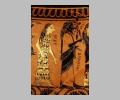
Upper frieze: wedding of Peleus and Thetis: Hebe and Dionysos

Middle frieze: panther
[Image not available]
Room with three-dimensional approximations of Greek vases in the British M...

Middle frieze: boar

Upper frieze: wedding of Peleus and Thetis: Hephaistos and Altheia

Middle frieze: ram
| Collection: | London, British Museum |
| Summary: | Wedding of Peleus and Thetis; animal friezes. |
| Ware: | Attic Black Figure |
| Painter: | Signed by Sophilos |
| Date: | ca. 580 BC |
| Dimensions: | Total H. 0.71 m., H. Bowl 0.28 m., D. Rim 0.326 m., Max. D. Bowl 0.415 m., H. (Stand) 0.47 m., D. Base (Stand) 0.331 m. |
| Shape: | Dinos |
| Beazley Number: | 350099 |
| Period: | Archaic |
Decoration Description:
Bowl: four registers of decoration. Upper register: wedding of Peleus and Thetis, and procession of gods to the palace of Peleus. The palace is at the right of the frieze, apparently distyle in antis, the two columns painted white with Doric capitals, the antae painted black and with different capitals. The entablature is simple, with minimal black triglyphs separating wide white metopes. Behind the porch is a double door painted red with red circles representing bronze studs. To the left of the left-hand column is the artist's signature,
Behind these goddesses comes Dionysos, holding an ivy branch and wearing a long chiton and himation. He seems to be talking (to Peleus?) since his lips are parted. He forms the central figure of the procession, placed directly above the central palmette of the frieze below as on the François Vase (
Behind this procession is a series of chariots and walking deities. The first chariot carries Zeus and Hera, Zeus wearing a chiton and cloak, and holding the reins and a whip, while Hera cloaks herself with one hand while holding to the chariot with the other. Behind the black horses are three goddesses, whose names are lost but may be Horai. They wear reserved chitons like Dionysos'. Behind this group, Poseidon and Amphitrite ride in a chariot accompanied by three Charites. Next, the chariot of Ares and Aphrodite, with five Muses in an arc behind the chariot. The central Muse is fully frontal and plays a syrinx. All the Muses wear reserved chitons. Hermes drives the next chariot, accompanied by Apollo. Hermes wears a short chiton with a rosette decoration, winged boots and a petasos, and his heralds staff leans against the chariot box. Apollo plays the kithara and sings. Behind their horses walk three more Muses, one wearing a decorated peplos and cloak. The last chariot is driven by Athena, with Artemis as her companion. Artemis wears a decorated peplos and no cloak, and holds a bow; Athena, a cloak, but no aegis or other attribute. Behind their horses walk three Moirai.
Behind these chariots comes Okeanos, fish-bodied and bull-horned, holding a fish and snake, accompanied by his wife Tethys and by Eileithyia. The procession is ended by Hephaistos riding on an mule, wearing a white chiton and apparently riding side-saddle on a swan-headed saddle (as on the François Vase; one frontal foot is preserved).
Below this register, three registers of animal friezes: bulls, boars, lions, deer, panthers, goats, sphinxes, birds, and an elaborate lotus and palmette ornament under the center of the procession. Stand: lotus and palmette chain and animal friezes.
The subject of the wedding of Peleus and Thetis was painted by Sophilos on another, very similar krater, fragments of which were found on the Athenian Acropolis (
Shape Description:
dinos and stand
Inscriptions:
Signed by Sophilos as painter: (retr.)
Collection History:
Purchased in 1971 by British Museum.
Sources Used: